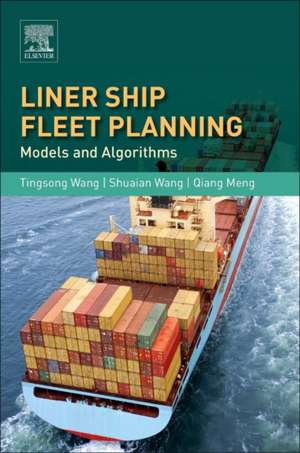Liner Ship Fleet Planning: Models and Algorithms
Autor Tingsong Wang, Shuaian Wang, Qiang Mengen Limba Engleză Paperback – 17 mai 2017
Current and future shipping professionals require systematic approaches for investigating and solving their fleet planning problems, as well as methodologies for addressing their other shipping responsibilities. Liner Ship Fleet Planning addresses these needs, providing the most recent quantitative research of liner shipping in maritime transportation. The research and methods provided assist those tasked with optimizing shipping efficiency and fleet deployment in the face of uncertain demand. Suitable for those with any level of quantitative background, the book serves as a valuable resource for both maritime academics, and shipping professionals involved in planning and scheduling departments.
- Introduces the latest research on maritime transportation problems
- Analyzes problems of liner ship fleet planning, taking uncertainty into account
- Promotes the use of mathematics to manage uncertainty, using stochastic programming models, and proposing solution algorithms to solve proposed models
- Includes case studies that provide detailed examples of real-world examples of fleet optimization
- Explains how stochastic programming modeling methods and solution algorithms can be applied to other research fields featuring uncertainty, such as container yard planning, berth allocation and vehicle deployment problems
Preț: 575.14 lei
Preț vechi: 754.40 lei
-24% Nou
Puncte Express: 863
Preț estimativ în valută:
110.06€ • 117.68$ • 91.76£
110.06€ • 117.68$ • 91.76£
Carte tipărită la comandă
Livrare economică 11-25 aprilie
Preluare comenzi: 021 569.72.76
Specificații
ISBN-13: 9780128115022
ISBN-10: 0128115025
Pagini: 204
Dimensiuni: 152 x 229 x 18 mm
Editura: ELSEVIER SCIENCE
ISBN-10: 0128115025
Pagini: 204
Dimensiuni: 152 x 229 x 18 mm
Editura: ELSEVIER SCIENCE
Public țintă
- Postgraduates and academics in maritime transportation, shipping management and maritime economics,
- Practitioners in planning and scheduling for shipping companies.
- Shipping and port government officials involved with policy-making and planning.
Cuprins
Part I: Introduction1. Introduction to Shipping Services2. Liner Ship Fleet Planning
Part II: Mathematical Modelling3. Introduction to Stochastic Programming4. Chance Constrained Programming5. Two-Stage Stochastic Model
Part III: Solution Algorithms6. Sample Average Approximation7. Dual Decomposition and Lagrangian Relaxation
Part IV: Case Studies8. Liner Ship Fleet Planning Problem with Individual Chance-Constrained Service Level9. Liner Ship Fleet Planning Problem with Joint Chance-Constrained Service Level10. Liner Ship Fleet Planning with Expected-Profit Maximization11. Multi-Period Liner Ship Fleet Planning
Part V: Conclusion12. Conclusions and Future Outlook
Part II: Mathematical Modelling3. Introduction to Stochastic Programming4. Chance Constrained Programming5. Two-Stage Stochastic Model
Part III: Solution Algorithms6. Sample Average Approximation7. Dual Decomposition and Lagrangian Relaxation
Part IV: Case Studies8. Liner Ship Fleet Planning Problem with Individual Chance-Constrained Service Level9. Liner Ship Fleet Planning Problem with Joint Chance-Constrained Service Level10. Liner Ship Fleet Planning with Expected-Profit Maximization11. Multi-Period Liner Ship Fleet Planning
Part V: Conclusion12. Conclusions and Future Outlook



























